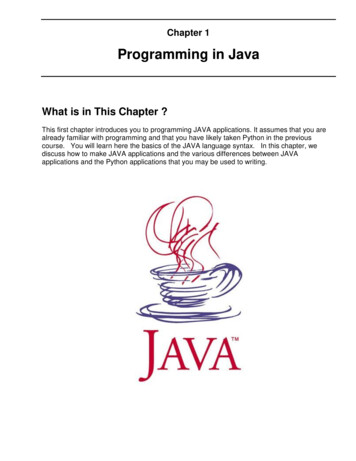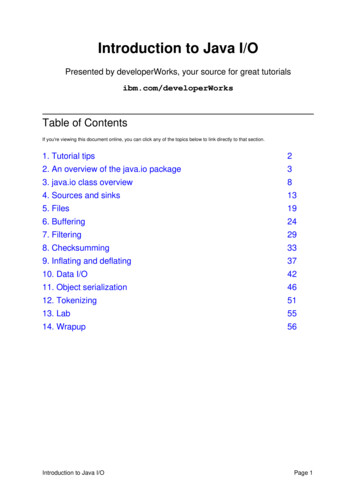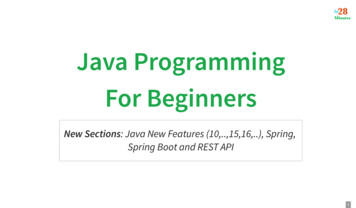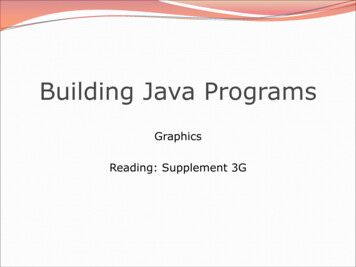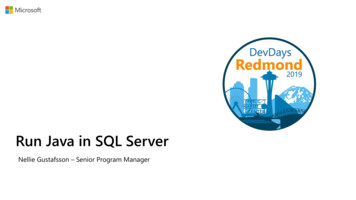
Transcription
Bachelor of Science in Computer ScienceFebruary 2019Performance comparison of Java and C when sorting integers and writing/reading files.Suraj SharmaFaculty of Computing, Blekinge Institute of Technology, 371 79 Karlskrona, Sweden
This thesis is submitted to the Faculty of Computing at Blekinge Institute of Technology inpartial fulfilment of the requirements for the degree of Bachelor of Science in ComputerSciences. The thesis is equivalent to 20 weeks of full-time studies.The authors declare that they are the sole authors of this thesis and that they have not used any sourcesother than those listed in the bibliography and identified as references. They further declare that theyhave not submitted this thesis at any other institution to obtain a degree.Contact Information:Author(s):Suraj SharmaE-mail: sush15@student.bth.seUniversity advisor:Dr. Prashant GoswamiDepartment of Creative TechnologiesFaculty of ComputingBlekinge Institute of TechnologySE-371 79 Karlskrona, SwedenInternetPhoneFax: www.bth.se: 46 455 38 50 00: 46 455 38 50 57ii
ABSTRACTThis study is conducted to show the strengths and weaknesses of C and Java in three areas that areused often in programming; loading, sorting and saving data. Performance and scalability are largefactors in software development and choosing the right programming language is often a long process.It is important to conduct these types of direct comparison studies to properly identify strengths andweaknesses of programming languages.Two applications were created, one using C and one using Java. Apart from a few syntax andnecessary differences, both are as close to being identical as possible. Each application loads three filescontaining 1000, 10000 and 100000 randomly ordered integers. These files are pre-created and alwayscontain the same values. They are randomly generated by another small application before testing.The test runs three times, once for each file. When the data is loaded, it is sorted using quicksort. Thedata is reset using the dataset file and sorted again using insertion-sort. The sorted data is then saved toa file. Each test runs 50 times in a large loop and the times for loading, sorting and saving the data aresaved. In total, 300 tests are run between the C and the Java application.The results show that Java has a total time that is faster than C and it is also faster when loading twoout of three datasets. C was generally faster when sorting the datasets using both algorithms and whensaving the data to files.In general Java was faster in this study, but when processing the data and when under heavy load, C performed better. The main difference was when loading the files. The way that Java loads the data froma file is very different from C , even though both applications read the files character by character,Java’s “Scanner” library converts data before it parses it. With some optimization, for example byreading the file line by line and then parsing the data, C could be comparable or faster, but for thesake of this study, the input methods that were chosen were seemingly the fairest.Keywords: Java, C , Programming languagesiii
ACKNOWLEDGEMENTSI would like to thank Dr. Prashant Goswami for his help during the writing of this thesis.iv
CONTENTSABSTRACT . IIIACKNOWLEDGEMENTS . IVCONTENTS . VLIST OF FIGURES . 6LIST OF TABLES . 7LIST OF GRAPHS . 81.INTRODUCTION . 91.11.21.31.41.52RELATED WORK . 122.13BACKGROUND . 13METHOD . 143.13.23.33.43.53.63.74JAVA . 10C . 10AIM . 10OBJECTIVES . 11RESEARCH QUESTIONS . 11INTRODUCTION TO EXPERIMENT . 14THE TESTING ENVIRONMENT AND SETTINGS . 14THE EXPERIMENT . 15TIME LIBRARIES FOR C AND JAVA . 15THE QUICKSORT ALGORITHM . 16THE INSERTION-SORT ALGORITHM . 17DIFFERENCES BETWEEN APPLICATIONS . 18RESULTS . 194.14.24.3C TIMES . 19JAVA TIMES . 19COMPARISON DIAGRAMS . 205ANALYSIS AND DISCUSSION . 236CONCLUSION AND FUTURE WORK . 24REFERENCES . 25v
LIST OF FIGURESFigure 4: The application design on page 14.6
LIST OF TABLESTable 1: The resulting times for the C application on page 19.Table 2: The resulting times for the Java application on page 19.7
LIST OF GRAPHSGraph 1: Comparison of load times 20.Graph 2: Comparison of quicksort times 20.Graph 3: Comparison of insertion-sort times 21.Graph 4: Comparison of save times 21.Graph 5: Comparison of total times 22.8
1.INTRODUCTIONProgramming languages come in many different variations with each being unique in its area of use.When it comes to how well an application performs, and scales, depends highly on what language isused, and the programmers experience with that language. Learning the strengths and weaknesses ofdifferent languages is key to making an application perform and scale well on the target platform. Thepurpose of this study is to compare two languages, C and Java, that have many similarities but areexecuted in a very different way. There are many parts to a language, therefore comparing them in theirentireties is out of the scope of this study. Rather, the focus will lie on the functionalities that are oftenused in almost all types of applications; loading or otherwise initializing, sorting and saving data. Theresults gathered from the comparison will show how these languages differ in these specific aspects andwhat their strengths and weaknesses are.There are several levels of programming languages ranging from low to high. The higher level alanguage is, the higher the level of abstraction is, and these are often interpreted languages that are notcompiled. They are executed on a line-by-line basis by an interpreter that is running in the background,and thus require no compilation times and have a less complicated syntax. Programmers can easilychange values mid-execution to see differences. These scripting languages, as they are also called, arealso more accessible to programmers with less experience because of their more simplified syntax andmore flexible and forgiving framework. Larger applications often combine higher and lower levellanguages for the most balanced and flexible results. The added overhead of the interpreted languagecan often be overseen when looking at the bigger picture and what is gained. A good example of theflexibility such higher level languages provide is often a “garbage collector”. This background processquietly but efficiently clears the dynamic memory allocated by the programmer so that the memory doesnot have to be deallocated manually which can often lead to unintended memory leaks. Such luxuries inprogramming surely come with the cost of overhead, but once again, this can be overseen in the light ofthe development being faster and less prone to errors.Lower level languages often have a less programmer friendly syntax and offer few to no luxuries interms of background helper processes. Memory must be deallocated manually otherwise the applicationwill have memory leaks which can often be hard to find. New programmers that are not accustomed tothe specific lower level language will find it hard to debug and update the code since more experienceis required to master the syntax. The style of programming and the knowledge of performance-boostingalgorithms is always important, no matter what language is used, but there are often smaller, languagespecific keywords and types that can be used to greatly increase the performance and scalability of anapplication when using lower level languages. These are often not found in higher level languages asthe interpreter handles most of the optimization by itself and only leaves a simple set of functions to beused by the developer. Lower level languages are compiled to machine or hardware code which is asclose to the hardware as can be. This language is numerical and contains the set of instructions that aresent to the Central processing unit, CPU, for execution. Machine code is easily read by the computer,so the speed of execution is extremely quick, but to compile a larger program can take several minutesto hours. Making changes can sometimes be tedious and time consuming since the application must bere-compiled each time a change is made.In this study, the comparison of C and Java is essentially a comparison of a higher and lower levellanguage. C being on the lower end, and Java being on the higher. Java and C are popular languagesthat are the basis for many backend applications and games. They are both object-oriented and veryflexible in terms of the syntax and libraries available.There are many opinions on C and Java and which one is more flexible or faster. Specially in the pastthere were many differences between languages and there were fewer optimizations as well as compilertweaks like the Java JIT compiler which speeds up the compilation to bytecode. This can be seen in theopinions from a 1999 study by Prechelt. L, where C and Java’s efficiency was compared [4]: "Therelative efficiency of Java programs is much discussed today, particularly in comparison to well-9
established implementation languages such as C or C . Java is often considered very slow andmemory-intensive". In another study by Nikishkov, G. P., Nikishkov, Y. G., & Savchenko, V. V. (2003)it was stated that [13]; “Although Java has attractive features for producing portable, architecturallyneutral code, it is not widely used in engineering computations. Slower speed of Java codes is usuallyconsidered its main disadvantage”.1.1JavaJava is not a scripting language, but much like one, it runs on top of an interpreter. The interpreter ismore of an engine that reads the code and executes it in a platform independent way. This engine consistsof two parts, the Java runtime environment, JRE, and the Java virtual machine, JVM. These two partswork together to interpret the code and run it on any platform that supports Java. This engine is writtenin different lower level languages that are supported on the different platforms, for example C or evenC . The main reason for this, as mentioned before, is to make the code platform independent so thatJava can run on many different computers and devices without programmers needing to learn a newlanguage for each of them. This engine has helper functions running in the background, for example thegarbage collector that was mentioned before. All of this adds overhead but also makes the languagemore flexible and easier to use. On today’s powerful machines, this overhead can be considered minimal,especially with the number of cores and the amount of memory that is available. Although, for largerapplications, this might still cause a dip in general performance.In a 2011 study by Oancea, B., Rosca, I. G., Andrei, T., & Iacob, A. I. [3] Java was tested as a backendapplication language and although it has more overhead, the results were favorable. They stated that itis a common belief that Java is still slower than C and C or even Fortran in performance, especiallyfor computationally intensive numerical applications. But they developed a library for matrixcomputations using a set of optimized techniques, and it was compared to its competitors. The resultsshowed that Java can achieve a performance comparable with other libraries developed in C, C orFortran. This shows that Java does not lose by default when its performance is compared to lower levellanguages.1.2C C is the object-oriented successor to the popular language C. It is considered quite a low to mid-levellanguage since it offers little in the way of abstraction and simplified syntax. C is compiled to machinecode that contains the translated instructions which are then sent to the processor for execution. Thismakes C quite a low-level language that offers a lot in the way of micro-managing almost everyaspect of the application. Managing memory allocation and deallocation is up to the programmer andthere are many ways to create bugs if one is not careful. There are many libraries that offer extendedfunctionality, like threads. Mastering C takes many years of experience, and it is constantly evolvingand being optimized. Many applications have their backend built using C as it offers both greatflexibility and an abundance of functionalities, although it is not multiplatform in the same way as Javais, rather there are different compilers for all the platforms that support the language, like Linux,Microsoft Windows and Mac Os There are also some syntax and library differences that need to beconsidered when porting an applications between platforms. Usually a C application is more complexand not as easy to program. As was seen in the 1999 study by Phipps, G. [1], C code is more proneto bugs, longer development times and more bugs per minute than Java. But it has more features in itsstandard library [5] and thus a larger ability to optimize the code.1.3AimThis study aims to compare the performance and scalability of C and Java when sorting,saving and loading large datasets.10
1.4 1.5 ObjectivesConstructing two identical applications for C and Java.Loading three increasingly large datasets into the applications.Sorting the large datasets and saving them into files.Running the applications and gathering and comparing the timings for each dataset.Identifying and explaining the reasons for performance and scalability differences.Research questionsWhat are the differences between C and Java’s performance and scalability in terms ofloading and saving large datasets to and from files?What differences are there between C and Java performance when sorting largedatasets using the sorting algorithms quick sort and insertion-sort?11
2 RELATED WORKNot much recent work has been done to specifically compare C and Java in this way. Research israther done on specific libraries and their functionalities within the same language. But that is not to saythat no work has been done. Although some of the work is not very recent, it still shines a light on thestrengths and weaknesses of the languages that are tested.There are a few different types of studies that have been conducted. One type is where languages aretested for their ease of use and flexibility like this older study from 1999 by Phipps, G. [1], an experimentwas conducted to compare C programming and Java programming cleanliness and ease of use. Theirresults were that a typical C program had about two to three times as many bugs as a typical Javaprogram and generated between 15 to 50 percent mote defects per line. Java was also between 30 to 200percent more productive. C also had about two to three times as many bugs per hour.The other types of studies compare the general performance of the languages by creating applicationsmuch like this study, but on a larger scale. Like this study from 2008 Fourment, M. and Gillings, M.R.[2], they compared Java and C in bioinformatics. Here they found that: "implementations in C andC were fastest and used the least memory. Programs in these languages generally contained morelines of code. Java and C# appeared to be a compromise between the flexibility of Perl and Python andthe fast performance of C and C .". This reflects the foundation that this study is built upon; that thecomplexity versus functionality problem of choosing a language is important depending on the requiredsystem being built.In a study from 1999 by Prechet, L. [4], Java, C and C were compared by creating similar applications40 times using different programmers and the general efficiency noted. They found that Java had ahigher memory consumption and slower processing speeds compared to C and C , but they mentionedthat the skill of the programmers could affect the results, so Java could very well be as efficient as, ormore than its competitors. This made the programming style and the experience of the programmers asimportant as the languages capabilities. In a direct quote from the study: “ The programming probleminvestigated here required a non-trivial algorithm and data structure design. However, the dataclearly shows that the importance of an efficient technical infrastructure (such aslanguage/compiler, operating system, or even hardware) is often vastly overestimated compared tothe importance of a good program design and an economical programming style”.In another study by Saiedian, H., & Hill, S. in 2003 [5], the general programming libraries of C andJava were compared. These libraries are the core of these languages as they allow programmers to pickfrom an array of standard functionalities that are well optimized and maintained by their respectivedevelopment teams. These libraries are the Standard Template Library (STL) and the Java DevelopmentKit (JDK) for C and Java respectively. The libraries were tested for compile size, runtime memoryusage and performance. The results were: “Based on the results, we conclude that the support providedfor generic programming in C 's STL is superior to that provided by JDK.”. These results are importantbecause the libraries used strongly affect the general performance of an application as the more flexiblelibrary has more ways to optimize the system.In the year 2000 study by Prechet, L. [6] they compared seven programming languages (C, C , Java,Perl, Python, Rexx and Tcl) directly to one another by creating 80 similar applications using differentprogrammers. The comparison investigated several aspects of each language, including program length,programming effort, runtime efficiency, memory consumption, and reliability.They found that scripting languages are written in about half the time as their lower-level competitorsand the amount of code is also half as long, but their memory consumption was in general twice as high.No clear differences in readability were observed. C and C were almost two to three times faster thanJava in the different tasks performed and about five to ten times faster than the scripting languages.Here, the skill of the programmers and the language used highly impact the results, but generally theresults clearly show that scripting languages are slower but easier to write and test. Lower level12
languages are harder to master but are generally faster, and Java, being a low-mid level language doessuffer drawbacks because of its interpreted nature.There is a study from 2013 by Nuzman, D., Eres, R., Dyshel, S., Zalmanovici, M., & Castanos, J. [12]which highlights a very good point about languages which can be extremely optimized and have thefastest speed versus more easily accessible languages that are still fast but much easier to understandand modify. It asks if it is possible to retain the performance of C while compiling it in a similar wayto Java using a JIT compiler that interprets the code. They found that: “Dynamic optimization has thepremise of taking advantage of runtime information to dramatically boost performance; however, in thedomain of statically compiled languages, this approach has so far had limited success, due to the costsassociated with dynamic profiling and recompilation”.2.1BackgroundThis study is conducted to show the strengths and weaknesses of C and Java in three areas that areused often in programming; loading, sorting and saving data.It is important to compare languages directly as there is too little research done in this area. This is alsothe opinion of the year 2000 study by Prechelt, L. [6]: "Often heated, debates regarding differentprogramming languages' effectiveness remain inconclusive because of scarce data and a lack of directcomparisons.”.Performance and scalability are large factors in software development and choosing the rightprogramming language is often a long process. Companies often choose higher level languages likepython or JavaScript because of their ease of use and large flexibility, but when it comes to performancea low-level language is always preferred. Some backend systems need to handle lots of file input andoutput effectively, and others might need to process data in different ways, and some might do both.This study will compare C and Java in a reliable and fair way to see how they perform in these aspectsof programming.13
3 METHODTo answer the research questions, this thesis conducted a comparative study which used quantitativemeasurements to compare two programming languages in their ability to load, sort and save increasingamounts of data. Two identical applications were created in both C and Java. Loading sorting andsaving are individually timed in both applications and these results are then compared with each other.Figure 1 “The application design.”As can be seen in the image, three pre-generated files containing randomly ordered integers were createdusing a separate application. These were then loaded into the application. The data was sorted usingquicksort and insertion-sort and finally the sorted data was saved to a file. This was done 50 times foreach of the dataset sizes. The times for each procedure in each iteration was saved and, in the end, anaverage time was calculated for all above mentioned procedures as well as the total iteration times.3.1Introduction to experimentTwo applications were created using an identical design, but one was programmed using C and theother one using Java. There are a few syntax differences that will be explained below, but eachapplication aims to be as identical as possible. Both applications were programmed by the sameprogrammer with high experience of both languages.3.2The testing environment and settingsThe applications were created in different integrated development environments, or IDE’s. The Javaapplication was created in Eclipse, and C application was programmed in Visual Studio 2017. Bothprojects were created as 32-bit. This test was done on a 64-bit Windows 10 machine with 16 GB ofRAM, an i7 Processor running at 2.6 GHz.Java does not have the same options as C when it comes to compiler optimization of the code sinceit is compiled by its own javac-compiler [11] and turned into bytecode which is then run on the JVM.This compiler optimizes the code automatically. To make this comparison as fair as possible, the C integrated development environment, or IDE, was set up to optimize the code using the O2 flag and run14
the code in release mode, which skips the debugging overhead and optimizes the code as much aspossible.3.3The experimentThe applications loaded pre-generated input data, that was stored in files as random integers rangingbetween 1 and the size of the dataset. This data was pre-generated by another application once beforethe tests were run. The loaded data was stored in a dynamically allocated array. The array was thensorted once using the quicksort algorithm. It was then reset using the current dataset file the experimentwas using, and then it was sorted again using the insertion-sort algorithm. Finally, the sorted array wassaved into a text file. The loading, sorting and saving methods were timed separately and any otherstatement which was not to be timed was ignored.The dataset sizes were 1000 (one thousand), 10000 (ten thousand) and 100000 (one hundred thousand)and consisted of integers. The applications were run once using each of the datasets, and each loading,sorting and saving test was done 50 times. These were pre-generated to be the same throughout the entiretesting process. Random values can give largely varying results while sorting and thus unfair advantages.The reason for using two algorithms was that it would test the performance of recursively sorting dataand sorting it using more simple means. There were other candidates for example heap-sort instead ofquicksort, and bubble-sort instead of insertion-sort, but in the end, quicksort was chosen as it is widelyused, easy to implement and it is one of the fastest sorting algorithms. Insertion-sort was chosen becauseit is not as slow as bubble-sort, it can be used with a larger dataset size like 100000 integers, it can beeasily implemented, and it has acceptable performance when sorting smaller datasets.After both applications were run three times each for all the datasets, there were six resulting files withthe times. Both applications were run for 150 iterations each resulting in 300 total iterations combined.3.4Time libraries for C and JavaTo time the C application, the standard library “ctime” [11] was used. This library contains the“clock t” type and “clock” function. These are used in combination to get the current processor-tickssince the system started. To get the elapsed time for an event, for example the loading of data, the starttime was subtracted from the end time. This was done by collecting the current time before the eventand once after the event. The exact way this was done for one of the functions is shown in the belowexample from the C application code.start std::clock();loadFromFile(arr, SIZE, FILENAME);duration static cast long (((std::clock() - start) / (double)CLOCKS PER SEC) *1000.0);For the Java application, the standard “System” package was used which has a built-in time function.To gather the time in milliseconds for a specific event, the “currentTimeMillis” function [14] was usedin the same way it was for C . One measurement was taken at the start of an event and one at the end,these values were then subtracted to get the elapsed time. The exact way this was done for one of thefunctions is shown in the below example from the Java application code.15
start ME, arr, SIZE);} catch (IOException e1){e1.printStackTrace();}duration System.currentTimeMillis() - start;3.5The quicksort algorithmQuicksort is a recursive sorting algorithm that uses a divide and conquer process to sort smaller chunksof a larger dataset and then put them all together in the end. This algorithm is most effective for largearrays.To start the sorting algorithm, a pivot value is chosen from the end of the array. The array is sorted byplacing the numbers that are smaller than the pivot to the left and the numbers that are larger to the right.After this procedure, the smaller numbers and the larger numbers are sorted individually as two differentarrays using their o
to hours. Making changes can sometimes be tedious and time consuming since the application must be re-compiled each time a change is made. In this study, the comparison of C and Java is essentially a comparison of a higher and lower level language. C being on the lower end, and Java being on the higher. Java and C are popular languages


